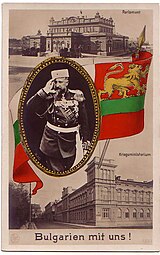
The Struma operation or Battle of Struma was a successfull offensive operation of the Bulgarian army during the First World War between 17 - 23 August 1916 in which they conquered all Greek territory east of the Struma river.
Background
In August 1916 Romania chose to join the war effort on the side of the Entente. The Allies planned a large offensive in the Macedonian Front for the middle of August in order to support Romania's entry in the war and pin down as many Bulgarian forces as possible. The Bulgarian high command suspected an impending offensive and the fighting around Doiran that erupted on 9 August only confirmed these suspicions. On their part the Bulgarians had urged for an offensive in Macedonia since the beginning of the year and now planned a strike with the First Army and Second Army on both Allied flanks.
The plan on the eastern flank was to seize the Drama - Giumurdzhina railway and this objective was given to the Bulgarian Second Army and the 10th Aegean Division. For the operation general Todorov could rely on 58 battalions, 116 machine guns, 57 artillery batteries and 5 cavalry squadrons in his army and an additional 25 battalions, 24 machine guns, 31 batteries and 5 squadrons in the 10th Division.
Battle and consequences
The Struma Offensive began on 18 August with the 7th Rila, 11th Macedonian Division and the 3/2 Infantry Brigade and 10th Division advancing on a 230 kilometer long front. For 6 days the Bulgarian forces achieved all their objectives in the face of weak Greek and French resistance. The depth of the advance reached 80-90 kilometers and an area of 4,000 square kilometers was occupied. Most importantly however the Macedonian Front was shortened with 100 - 120 kilometers and the Greek IV Army Corps, numbering 464 officers and 6373 soldiers that was positioned in the area, was disbanded, its troops and armament were interned by the Germans in Silesia for the rest of the war.
The cities of Kavala, Drama and Serres were taken.
Source
- Template:Translation/Ref

